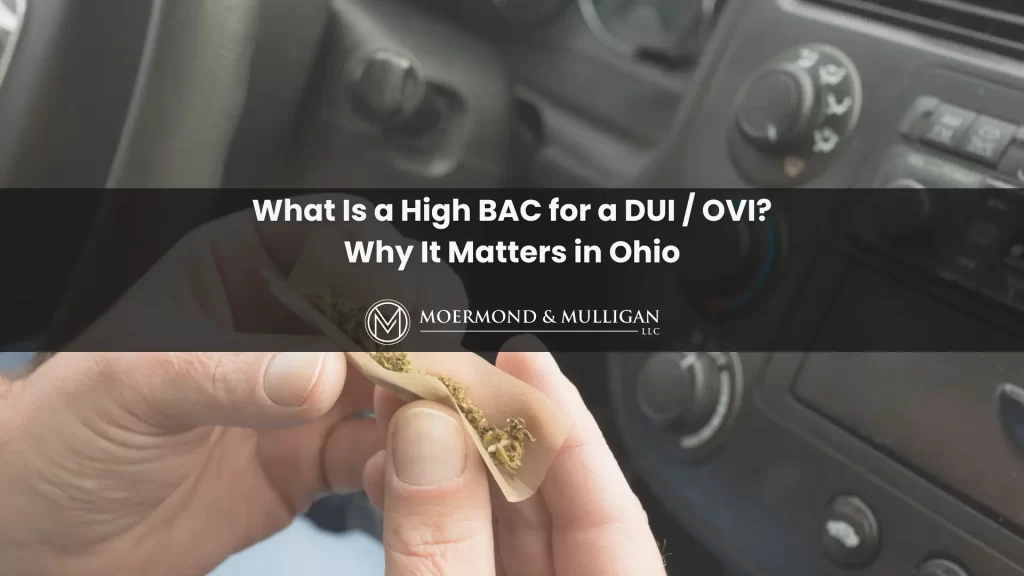Posted on Saturday, February 10th, 2024 at 9:00 am

It is a given that drunk driving is illegal. A drunk driving conviction can lead to legal and financial consequences. However, what most people don’t know is that a person’s blood alcohol concentration can significantly impact the potential consequences that they may face for their actions. What is a high BAC for a DUI / OVI, and why does it matter?
At Moermond & Mulligan, LLC, our OVI/DUI Lawyers wants to break down Ohio’s impaired driving laws and how the alcohol concentration in your blood during an incident can impact your case.
DUI and Blood Alcohol Concentration
It is vital to have a complete understanding of Ohio’s impaired driving laws and terminology when discussing blood alcohol concentration and how it can impact your case. In Ohio, driving under the influence is also called operating a vehicle under the influence or OVI. Law enforcement can arrest an individual and charge them with OVI when a driver has a blood alcohol concentration or BAC of .08 percent or higher, is under the influence of drugs or narcotics, or is impaired by drugs or alcohol to the point where their actions, reactions, or mental processes are adversely affected.
Like many other states, Ohio also has implied consent laws, meaning motorists lawfully arrested for OVI must submit to blood, urine, or breath testing to determine their BAC. Other tests include chemical tests and field sobriety tests to determine mental acuity. Refusing a traffic stop test can lead to additional consequences like a one-year suspension of an individual’s driver’s license.
Blood alcohol concentration (BAC) refers to the amount of alcohol present in a person’s blood from consuming alcoholic beverages. Alcohol is rapidly absorbed in the stomach and small intestines, entering the bloodstream quickly. The liver metabolizes alcohol to filter it out of the blood since alcohol is a toxin. A BAC of 0 percent means there is no alcohol in a person’s blood. At a BAC of .05 percent, an individual is not as alert and has impaired judgment. .08 percent is the legal limit for intoxication in many states, including Ohio. At this concentration, individuals experience loss of muscle coordination and impaired judgment, making them a danger to themselves and everyone they share the road with.
What’s a High BAC in Ohio?
What is a high BAC for a DUI / OVI? What’s a high BAC for a first-time DUI? For those found driving under the influence and have no previous record, the BAC should be lower than .08 percent. A high BAC means any percent higher than the legal limit, with an enhanced penalty for having a BAC above .17 percent. In Ohio, people operating a motor vehicle with a BAC of .17 or higher face high-tier OVI or high-test OVI. A BAC of .17 can cause a person to suffer nausea, vomiting, altered mood, loss of balance, loss of muscle control, confusion, and drowsiness.
Those arrested for operating a motor vehicle with a BAC of .17 or higher can face significantly more severe penalties, including steep fines and incarceration. A high-tier OVI conviction can also dramatically alter a person’s personal and professional reputation and cause tremendous complications when searching for jobs, housing, educational opportunities, and financial assistance.
Penalties for Driving with a High BAC

OVI penalties in Ohio can be significant. These penalties can increase in severity depending on the number of previous OVI arrests on a person’s criminal record. What are the penalties for a high BAC DUI? Penalties for an OVI conviction can include:
First-offense
- Fines between $375 and $1,075
- Driver’s license suspension from one to three years
- Jail time between three days and six months
Second-offense
- Fines between $525 and $1,625
- Driver’s license suspension from one to seven years
- Jail time between ten days and six months
Third-offense
- Fines between $850 and $2,750
- Driver’s license suspension from two to 12 years
- Jail time between 30 days and one year
The penalties for a high-tier OVI or aggravated OVI are more significant because a high-tier OVI is a felony offense. Penalties can include a mandatory minimum jail sentence of three days in jail and three days in an intervention program or six days in jail with a maximum jail sentence of six months. A high-tier OVI conviction can also result in fines and a driver’s license suspension between one year and three years.
Individuals are also put under an Administration License Suspension or ALS suspension, meaning they are not eligible to drive until at least 15 days past their offense date and must install yellow OVI plates on their vehicle. These unique license plates alert law enforcement that the driver has a high-tier OVI offense on their recent driving record.
Contact a Skilled DUI Criminal Defense Attorney Now
A high-tier OVI offense is even more severe than a standard OVI. The penalties of a DUI charge and DUI conviction can leave you reeling, giving you a criminal record and impacting everything from your career to your insurance rates. Never attempt to fight a high-tier OVI charge alone as defending against a high BAC DUI can be difficult. If you are arrested for DUI, get an experienced Cincinnati OVI/DUI lawyer immediately with Moermond & Mulligan, LLC on your side.
Contact us online or call our office at (513) 421-9790 now to arrange a free and confidential legal consultation. Our team of lawyers can give you the best possible results with our decades-long experience and successes.
Related Posts:
Written By: Moermond & Mulligan, LLC
Last Updated: 08-06-2025